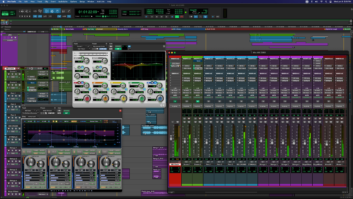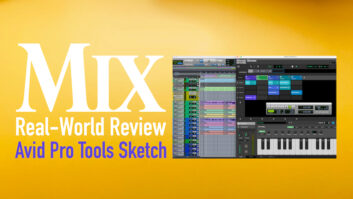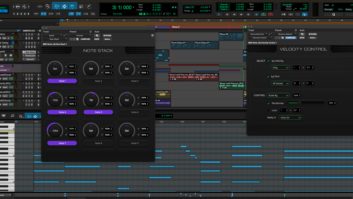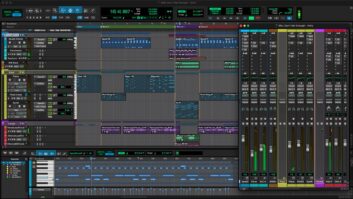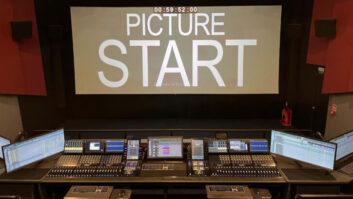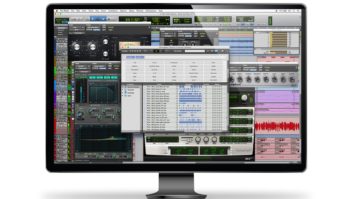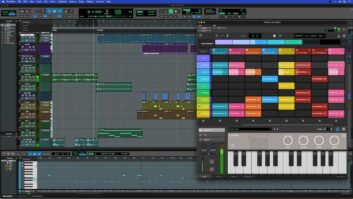After serving as the Pro Tools I/O standard for nearly nine years, AVID has discontinued the 192 I/O while simultaneously releasing a trio of new AVID Pro Tools HD Series interfaces: the HD OMNI, the HD I/O and the HD MADI. Besides compatibility with current Pro Tools HD systems, these new boxes seamlessly interface with the new Pro Tools HD Native system while promising more I/O flexibility and additional I/O options and improved converter quality over the 192.
Features
The new HD Series interfaces require Pro Tools 8.1 (a free upgrade to owners of PT 8.0) for operation. In addition to the interface support, PT HD 8.1 provides an improved I/O Setup and support for the HEAT (Harmonically Enhanced Algorithm Technology) software option. At this point, Pro Tools 8.1 is not available for Pro Tools LE, Pro Tools M-Powered or Pro Tools M-Powered Essential systems.
At first glance, the HD I/O appears to be nearly identical to the 192, but what’s inside reveals an entirely different beast than anything Avid has ever released. The analog section is completely redesigned, providing extremely high quality sound, and the performance is enhanced by the implementation of a new power supply design. The HD I/O ships in three basic configurations (each with 16 channels of I/O) of which each can be further customized. The HD I/O 8 x 8 x 8 provides eight channels of analog I/O and eight channels of digital I/O, the HD I/O 16 x 16 Analog provides 16 channels of analog I/O, and the HD I/O 16 x 16 Digital provides 16 channels of digital I/O. Each HD I/O Interface is equipped with 2- channels of AES I/O (XLR), 2-channels of S/PDIF I/O (RCA), ADAT/SMUX I/O (Light Pipe: 8 channels @ 48k, 4 channels @ 96k, or 2 channels @ 192k), Word Clock I/O (BNC), and Loop Sync I/O (BNC).
The HD I/O 8 x 8 x 8 has one and the HD I/O 16 x 16 Digital has two open card slots that can support one of the three card options. The ADC option card adds eight analog inputs, the DAC option card adds eight analog outputs, and the Digital option card adds eight channels of AES, ADAT (supports S/MUX 2 and 4), and TDIF connection. Sample rate conversion is available on all of the digital inputs and Curv — Avid’s new soft-knee analog limiter that is apparently its answer to Apogee’s SoftLimit circuit — is available on all of the analog inputs, switchable per channel. Curv smoothes fast transients allowing tracks to be recorded hotter (something that the recording community doesn’t necessarily need) but also works fantastically as protection against nasty digital distortion (something the recording community needs now more than ever).
The HD OMNI is an entirely new beast for Avid. This nonexpandable 1U box incorporates the same build quality as the HD I/O and essentially acts as a Pro Tools HD one-stop shop. The OMNI includes four analog input paths and eight analog output paths as well as a fully integrated monitoring section that provides control of up to 7.1 surround formats. Two independent cue paths are also provided. The box’s analog connectivity includes two mic/line/instrument inputs (XLR/ TRS) with inserts (TRS), four line-level inputs (TRS), two line-level outputs on TRS connectors or eight line-level outputs via DSUB. Digital connectivity includes two AES inputs (XLR), eight AES outputs (DSUB), two channels of S/PDIF I/O (RCA) and ADAT/SMUX I/O (8 channels @ 48k, 4 channels @ 96k, or 2 channels @ 192k). The OMNI’s I/O routing is completely user configurable providing up to 8 x 8 of I/O or up to 4 x 8 analog only I/O (not including the two cue channels).
 The OMNI’s architecture includes a 14-channel monitor mixer that is independently routable to two unique outputs allowing keyboards, drum machines, iPods, etc. to be monitored (this mixer continues to function even when the computer is powered down). Two multi-function knobs and dedicated switches on the front panel provide mic pre and monitor control providing quick and easy access to gain, monitoring level and other frequently altered settings. As with the HD I/O, sample rate conversion is available on all of the OMNI’s digital inputs and Curv on all of the analog inputs.
The OMNI’s architecture includes a 14-channel monitor mixer that is independently routable to two unique outputs allowing keyboards, drum machines, iPods, etc. to be monitored (this mixer continues to function even when the computer is powered down). Two multi-function knobs and dedicated switches on the front panel provide mic pre and monitor control providing quick and easy access to gain, monitoring level and other frequently altered settings. As with the HD I/O, sample rate conversion is available on all of the OMNI’s digital inputs and Curv on all of the analog inputs.
In Use
Although I’ve been a Pro Tools user since its infant days of answering to Sound Tools, I’ve never been overly fond of the sound of any of the Digi (now Avid) converters. While I’ve found some of them to be acceptable (barely), they’ve never been something I’ve been overly excited about recording or monitoring through. And while I’ve owned several of them over the years (including three 192s, a 96 IO and a couple of 888s), I’ve always used them to supplement converters that my ears find preferable and that I feel improve my work (such as the Lynx Aurora or the PrismSound ADA-8XR boxes). This said, I was excited about spending several weeks running the HD I/O and the OMNI through their paces to see how these new boxes stack up.
The HD Series interfaces utilize the new DigiLink mini connector to interface with a computer. The new Pro Tools HD Native PCIe core card utilizes this mini connector, and my hope is that there will be a HD Core and HD Accel card replacement in the near future (also utilizing the DigiLink mini connector), but for the time being, using the included adapter cable allows the new interfaces to interface with current HD rigs.
I put the HD OMNI and HD I/O boxes to work right away and found them quick and easy to configure and use. The HD OMNI’s I/O setup in Pro Tools was slightly confusing at first due to the new routing options, but I was able to figure it out without opening a manual (which is all I really ask from a hardware device). Before doing any critical listening comparisons, I jumped right into my normal workflow using the new boxes, and they operated flawlessly and sounded fantastic.
The OMNI is an excellent option for producers and engineers needing an all in one box without compromise. The potential of having simultaneously dedicated stereo and 5.1 surround outputs is wonderful and the headphone amp is audiophile quality. Using the mic pre for a handful of various overdubs revealed a surprisingly good mic preamp that, although it wouldn’t be my first choice in most recording situations, I would use it without hesitation even in critical situations.
The Curv circuit works well and, unless pushed to the extreme, remains transparent. I’ve found that while I prefer to always record with it engaged so it acts as a digital overload safety, I adjust my input levels so it never engages under normal operation (it begins to compress at -4.5 dBFs). I’m not a fan of sample-rate conversion, but occasionally it is a necessity and the built-in conversion in the HD Series Interfaces is easy to use and is as good as I’ve ever heard.
After a couple of weeks of use, I made time in my schedule to do some critical listening comparisons. I imported Michael Jackson’s “Don’t Stop ‘Til You Get Enough,” AC/DC’s “Back in Black,” and a fabulous recording of Edvard Grieg’s Piano Concerto into a Pro Tools session and simultaneously routed the output through the HD I/O, a Digidesign 192 and a Benchmark DAC; since the HD I/O and the OMNI use identical converters, I only included the HD I/O in my comparison tests. After calibrating the outputs on all three boxes, I had an assistant switch between converter outputs patching into the same monitor source on my console. To assure it was truly a blind test, I only knew the converters as A, B or C and — besides spending time acclimating to the sound of each box — I specifically listened to imaging, detail and high-frequency detail. I kept track of my preference in each category and when the testing was finished, I found that in almost every instance the HD I/O was my favorite. Its imaging was wider than the other two, the low-frequency detail was amazing and the top end was smooth and pristine with no hint of harshness. No surprise, but the 192 was always my least preferred converter of the bunch.
Realizing that playback is only part of the converter picture, I went on to perform a listening test to assess the converters ability to accurately and transparently capture (A/D) and reproduce (D/A) audio. Since the Benchmark converter is only a DAC, for this test it was replaced with the Lynx Aurora and, instead of playing back audio originating from a 44.1 kHz Red Book CD, I compared a live musician playing a Taylor 514-CE acoustic guitar through a pair of Earthworks SR-77s into a Gordon Model 3 stereo mic preamp. In this comparison, a fourth source was added to the equation: the direct output from the Gordon.
 I recorded at 24-bit/88.2 kHz. During the comparison, I was always aware of the source signal but the convertor source was again a blind test. Comparing the three converters to the direct signal yielded more dramatic results than the previous test, and the HD I/O provided the signal closest to the original. The imaging of the HD I/O was identical to the source material, which was not the case with the other two boxes and its depth and detail were pristine. The HD I/O’s high-frequency response was smooth and extended allowing all the subtleties of the string work on the guitar to come through in complete clarity.
I recorded at 24-bit/88.2 kHz. During the comparison, I was always aware of the source signal but the convertor source was again a blind test. Comparing the three converters to the direct signal yielded more dramatic results than the previous test, and the HD I/O provided the signal closest to the original. The imaging of the HD I/O was identical to the source material, which was not the case with the other two boxes and its depth and detail were pristine. The HD I/O’s high-frequency response was smooth and extended allowing all the subtleties of the string work on the guitar to come through in complete clarity.
As I’ve continued to work with the HD Series interfaces, I’ve been continually amazed at their detail, imaging and accuracy. The work I’ve done on the converters has translated perfectly into the real world, and they are a pleasure to monitor through.
The Pro Tools review rig included the new HEAT (Harmonically Enhanced Algorithm Technology) software option that was codeveloped with Crane Song’s Dave Hill. HEAT’s two simple global controls allow the character and warmth of analog summing to be dialed into a mix without leaving the box, and I’m happy to report it’s quite convincing. Look for Rich Tozzoli’s full review of HEAT next month (in PAR’s December 2010 issue).
Summary
I wasn’t surprised at the fantastic routing flexibility, monitoring or build quality of the new boxes, but I was surprised at the quality of their sound. With the release of the new HD Series Interfaces, Avid is on par with the best converters I have heard.
Russ Long is a Nashville-based producer, engineer and mixer as well as a senior contributor to PAR.
